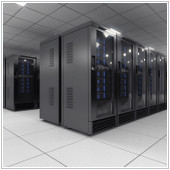 Servers have become an essential tool for many businesses. They manage and keep business data secure, and improve workplace productivity. However, overburdening your servers causes their operating temperatures to rise, which can lead to reduced server reliability and data loss. This is why it’s important to keep your servers constantly cool.
Servers have become an essential tool for many businesses. They manage and keep business data secure, and improve workplace productivity. However, overburdening your servers causes their operating temperatures to rise, which can lead to reduced server reliability and data loss. This is why it’s important to keep your servers constantly cool.
How does temperature affect servers?
High server temperatures can cause it to crash, resulting in costly data loss and service interruptions. If a server’s temperature rises above 70 degrees Fahrenheit, the server’s reliability decreases. In fact, an increase of 15 degrees leads to a 50-percent decrease in server reliability. When servers reach these temperatures, they will start to perform poorly, and computers connected to the server will start to struggle as well. Keeping your servers cool is vital to maintain optimal performance and longevity.
Effective methods to keep servers cool
-
- Use low-heat lighting
Incandescent lights produce too much heat that can raise the temperature of your server room. Go for low-heat options such as LED arrays and fluorescent tubes. Not only do they produce less heat, but they also provide better illumination compared to incandescent bulbs.
-
- Ensure your server room is well ventilated
Server rooms are usually small and contain other hardware aside from servers. Without proper air circulation, all that hardware can raise the temperature of the room and your servers. Make sure the server room you choose has good air circulation. If you have no choice but to place your server in a small room, install a ventilation system that will let hot air escape from the room.
-
- Use cooling fans
Cooling fans work well with a ventilation system to move hot air away from your servers. They are also a more affordable option to air conditioners. Placing a small and powerful fan next to your server’s heat vent will keep it from overheating.
-
- Air conditioning system
Installing an air conditioner in your server room is probably the best way to keep servers cool. Make sure that the air conditioner you choose is perfect for your server room. If you have a big server room, a small air conditioner won’t do much to cool it. Also, don’t be tempted to use residential air conditioners, as they are not designed to run 24/7/365. Go for industrial air conditioners instead. They can be a bit costly and require semi-annual maintenance checks, but industrial air conditioners will ensure your servers are constantly operating in cool temperatures.
Servers work best when kept at a cool temperature constantly. While manufacturers continue to build more resilient servers, proper care and maintenance still play a vital role in ensuring high operating quality and longevity. If you need more information about server management or have any other questions about your server setup, contact us today.



